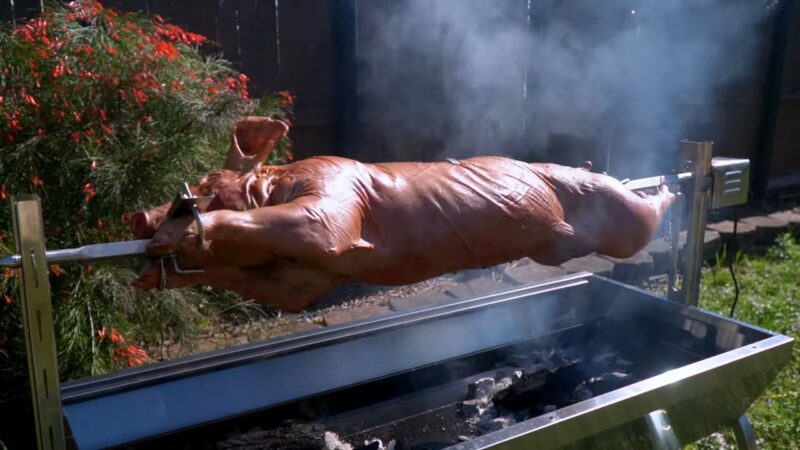Cooking a pig roast on a rotisserie spit is a fantastic way to impress your guests with a delicious and memorable meal. It’s an art that requires careful preparation and cooking techniques to ensure the pig is perfectly roasted, tender, and flavorful.
In this guide, I will take you through the step-by-step process of planning and executing a successful rotisserie pig roast, from gathering the necessary supplies to carving and serving the mouthwatering result.
Key Takeaways
- Construct a sturdy rotisserie spit using a steel pipe and supporting structures.
- Secure the pig to the spit using bailing wire or steel prongs to ensure even rotation.
- Prepare a fire pan or pit to protect the ground and catch drippings from the roasting pig.
- Season the pig with salt to enhance its natural flavors and create a delicious taste.
Gathering Supplies for the Pig Roast
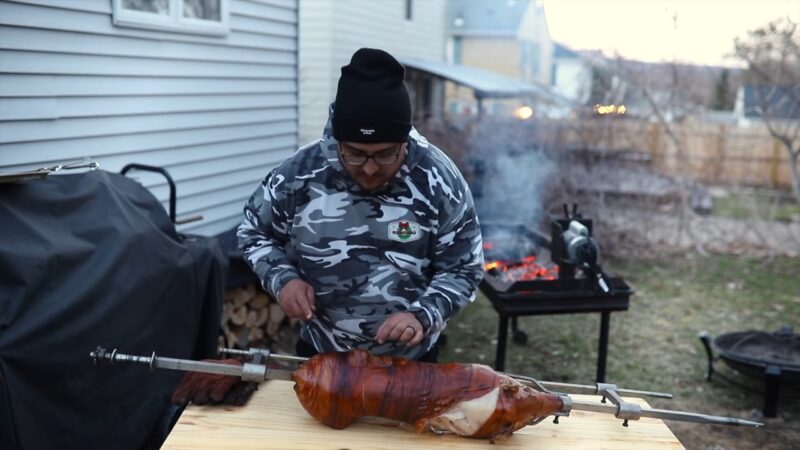
Before embarking on your rotisserie pig roast adventure, make sure you have all the necessary supplies and equipment ready. A successful pig roast requires careful planning and preparation to ensure everything runs smoothly. Here are some essential items you will need:
- Pig sourcing: Find a reputable source for your whole pig. Plan on approximately one pound of pig per person.
- Spit construction: Build a sturdy rotisserie spit using a steel pipe and supporting structures, such as cinder blocks or metal frames.
- Fire preparation: Prepare a fire pit or fire pan to protect the ground and catch drippings. This will also help create a consistent and controlled heat source for cooking the pig.
- Wood for the fire: Splitting a good amount of wood is essential to ensure you have enough coals for cooking. Using a mix of hardwoods like oak or hickory will provide a rich smoky flavor.
- Seasonings and ingredients: Don’t forget to stock up on salt for seasoning the pig. Other ingredients for side dishes like cole slaw and potatoes should also be included in your shopping list.
- Cooking utensils: Make sure you have a chimney starter to easily light the coals, a long set of tongs for arranging the coals and turning the pig, and a thermometer to monitor the internal temperature of the pig.
Table: Checklist for Pig Roast Supplies
| Item | Quantity |
|---|---|
| Whole pig | Approximately 1 pound per person |
| Steel pipe | 1 |
| Cinder blocks or metal frames | As needed |
| Fire pit or fire pan | 1 |
| Wood (hardwoods like oak or hickory) | Ample supply for generating coals |
| Salt and other desired seasonings | As needed |
| Ingredients for side dishes | According to your chosen recipes |
| Chimney starter | 1 |
| Long tongs | 1 pair |
| Thermometer | 1 |
By gathering all the necessary supplies and equipment, you can ensure that your pig roast event goes off without a hitch. The checklist and preparation tips provided here will help you get started on your rotisserie pig roast journey. So, gather your tools, source the perfect pig, and get ready to impress your guests with a delicious and memorable feast!
Building the Rotisserie Spit
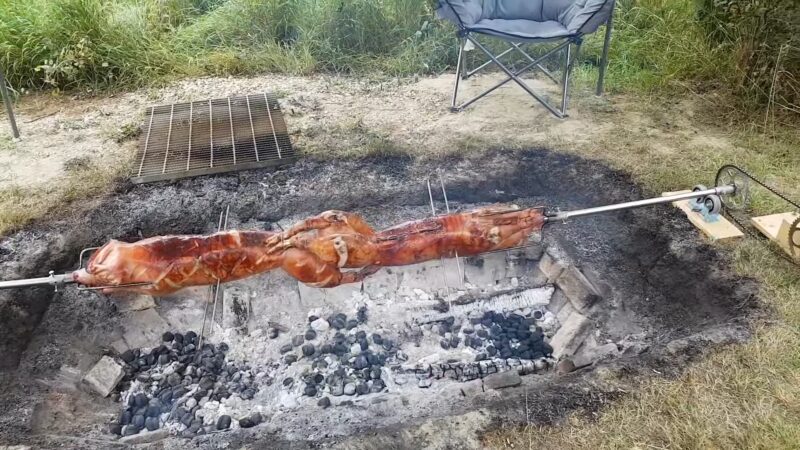
Building a sturdy and reliable rotisserie spit is essential for a successful pig roast that turns out juicy and flavorful. The key is to use a solid steel pipe as the main structure, supported by sturdy cinder blocks or other structures that can handle the weight of the pig. It is important to ensure that the spit is securely fastened and balanced, as any imbalance can lead to uneven cooking and potential accidents.
With the rotisserie spit properly constructed, you can now move on to securing the pig and preparing the fire pit for cooking. Building a solid and balanced spit provides the foundation for a successful and delicious rotisserie pig roast.
Keep in mind that the size of the pig will determine the length and thickness of the steel pipe needed. It’s important to select a pipe that can handle the weight of the pig without flexing or bending. Additionally, make sure the support structures are positioned in a way that allows for easy access to the pig for basting and monitoring the cooking process.
Once the rotisserie spit is securely assembled and balanced, you can proceed with confidence to the next steps of your pig roast preparation.
Securing the Pig to the Spit
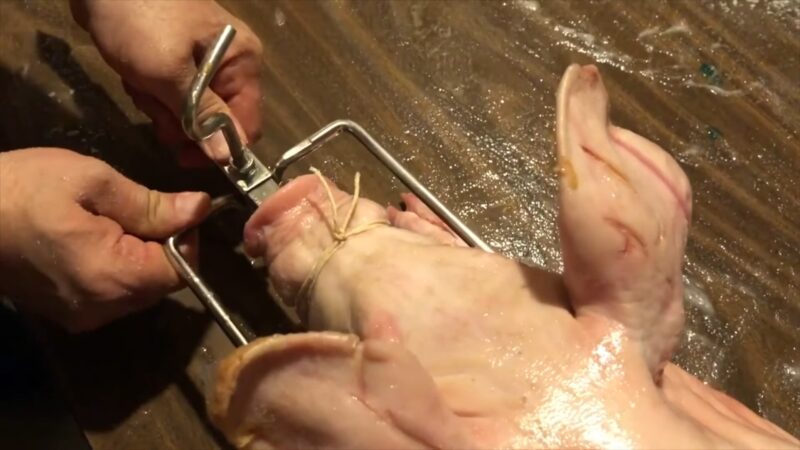
Properly securing the pig to the rotisserie spit ensures even cooking and prevents any unfortunate mishaps during the roasting process. There are a few methods you can use to ensure that your pig stays securely in place on the spit.
- One option is to use bailing wire to tightly fasten the pig to the spit. Start by positioning the pig on the spit and then tightly wrap the wire around the pig’s front and back legs to secure it to the spit. Make sure to twist the wire tightly so that it holds the pig firmly in place. This method works well for larger pigs and provides a strong hold.
- Another method is to use steel prongs to secure the pig to the spit. Insert the prongs into the pig’s back and hindquarters, making sure they are firmly embedded. These prongs will hold the pig in place as it rotates on the spit. This method is best for smaller pigs or if you prefer a more traditional approach.
Whichever method you choose, it’s important to ensure that the pig is centered and balanced on the spit. This will help to maintain an even distribution of heat and ensure that the pig cooks evenly. Take the time to adjust the positioning and balance of the pig before securing it in place.
Once the pig is securely fastened to the spit, it’s time to move on to the next step in the rotisserie pig roast process. With the pig in place, you can now focus on preparing the fire pit and getting the fire started. But before you do, take a moment to admire your handiwork and the anticipation of a delicious whole roasted pig.
Preparing the Fire Pit
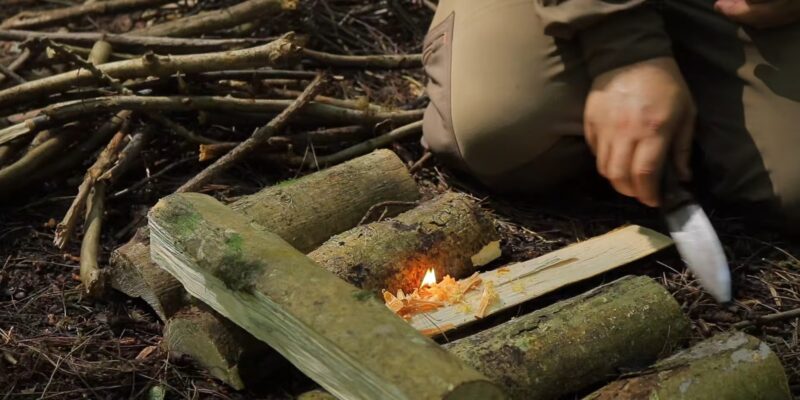
Before you start cooking the pig, it’s crucial to prepare a fire pit that will provide the consistent heat needed for a perfect roast. A fire pan or pit serves two purposes: protecting the ground from direct heat and catching any drippings from the pig. Here’s a step-by-step guide on how to prepare a fire pit for your BBQ pig roast:
- Choose a suitable location for your fire pit. Ensure it is away from any flammable materials and has enough space for the size of your pig and the cooking equipment.
- Clear the area of any debris and make sure the ground is level.
- Create a boundary for your fire pit using bricks or rocks, forming a circular or rectangular shape.
- Line the bottom of the pit with a layer of sand or gravel. This helps with drainage and prevents the bottom from becoming too hot.
- Place a metal grill or wire mesh on top of the pit. This will act as a support for the coals and prevent them from falling through.
- Start by lighting a small fire using kindling and newspaper in the center of the pit. Gradually add more wood and arrange it in a pyramid shape to ensure good airflow.
- Allow the fire to burn down until you have a bed of hot coals. This usually takes around 1-2 hours, depending on the size of your fire and the type of wood used.
- Once you have a good bed of coals, spread them evenly across the pit using a shovel or tongs. This will provide an even heat distribution for cooking.
Pro Tip: Splitting Wood for a Good Bed of Coals
Splitting wood is an essential part of preparing for a pig roast. It’s important to use well-seasoned hardwood, such as oak or hickory, as it burns hotter and produces better coals. Here are some tips for splitting wood:
- Use a splitting maul or axe with a sharp blade for easier splitting.
- Position the wood securely on a chopping block or a sturdy surface.
- Aim for the center of the log and strike it with a forceful swing.
- Repeat the process until you have enough split wood for your fire.
“A well-prepared fire pit and a good bed of coals are the foundations of a successful pig roast.” – BBQ Enthusiast
Now that your fire pit is ready, it’s time to move on to the exciting part – seasoning the pig and getting it prepared for cooking!
Seasoning the Pig
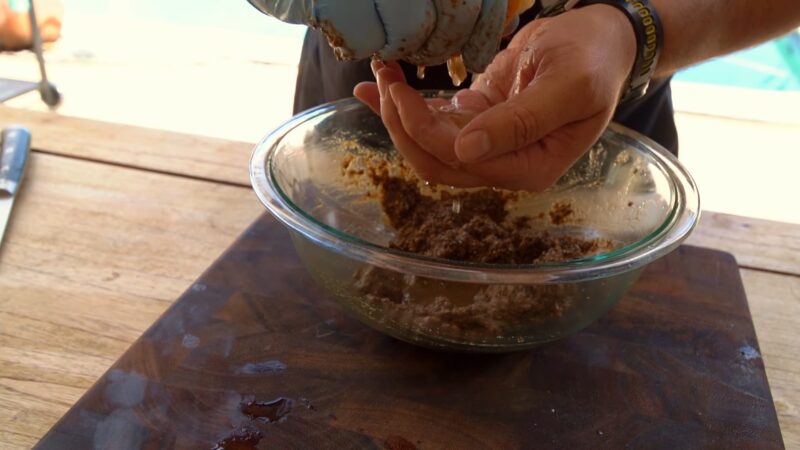
Once the pig is securely attached to the rotisserie spit, it’s time to season it with a generous amount of salt to bring out its delectable flavors. Seasoning the pig is a crucial step in achieving a truly delicious roasted pig. The salt helps to enhance the natural taste of the meat and creates a flavorful crust on the skin.
When seasoning the pig, make sure to apply salt liberally, ensuring that it covers the entire surface of the pig. This will help to ensure that every bite is well-seasoned and tasty. Additionally, you can add other seasonings such as pepper, garlic powder, or herbs to further enhance the flavor profile of the pig.
Remember to season the inside cavity of the pig as well, as this will infuse the meat with flavor from the inside out. A good rule of thumb is to use approximately 1 tablespoon of salt per pound of pig. However, feel free to adjust the amount to your personal taste.
Once the pig is properly seasoned, it’s time to move on to the next step in the cooking process. The flavors from the salt will penetrate the meat as it rotates on the spit, resulting in a succulent and flavorful roasted pig that will be the highlight of your pig roast event.
Cooking the Pig Roast
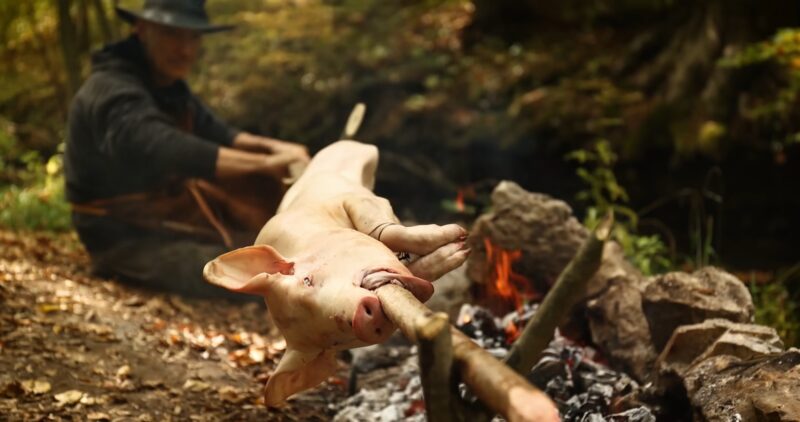
With the pig securely on the rotisserie spit and seasoned to perfection, it’s time to start cooking the star of the show. The key to a successful pig roast is maintaining a slow, even heat to ensure the meat is tender and juicy. Here’s a step-by-step guide to cooking your pig roast to perfection:
- Prepare the fire pit: Before lighting the fire, make sure the fire pit is clean and free from debris. Place the fire pan or pit in a safe area away from any flammable objects. This will protect the ground and catch any drippings from the pig.
- Light the coals: Use a chimney starter to light the coals, as this will provide an even and consistent heat. Once the coals are lit, carefully arrange them in a bed underneath the spit.
- Start the cooking process: Position the spit over the coals and start the rotisserie motor. It’s important to keep a close eye on the temperature to maintain a slow, even heat. You can use a meat thermometer to monitor the internal temperature of the pig.
- Cook low and slow: Cook the pig roast at a temperature of around 225-250°F (107-121°C) for the first few hours. This slow cooking method allows the meat to become tender and flavorful.
As the pig roast cooks, it’s important to periodically check the fire and add more coals if needed. This will ensure a consistent heat throughout the cooking process.
“Cooking a whole pig on a rotisserie spit is an art that requires patience and attention to detail. The slow cooking process allows the flavors to develop and the meat to become succulent,” says Chef John, a renowned expert in pig roasting. He adds,
“The key is to maintain a low, steady heat and resist the temptation to rush the cooking process. Slow and steady wins the race when it comes to a perfectly cooked pig roast!”
Increasing the heat for crispy skin
Once the pig roast is approaching the desired internal temperature, it’s time to increase the heat to crisp up the skin. This final step adds a delicious crunch and enhances the overall presentation of the pig roast.
Here’s how to achieve crispy skin:
- Arrange the coals: Move the coals closer to the pig roast to generate more intense heat. Position them directly underneath the skin for maximum crispiness.
- Monitor closely: Keep a close eye on the pig roast as the temperature increases. Rotate the spit regularly to ensure even browning of the skin.
- Remove and rest: Once the skin is golden brown and crispy, carefully remove the pig roast from the spit and transfer it to a large cutting board or serving platter. Allow the pig to rest for 15-30 minutes before carving.
Carving and serving the pig roast is the final step in this culinary adventure. Follow these instructions and you’ll be rewarded with beautifully cooked meat that is sure to impress your guests.
| Pig Roast Cooking Tips: | |
|---|---|
| TIP 1: | Use a meat thermometer to ensure the internal temperature of the pig reaches at least 160°F (71°C) to ensure it is fully cooked and safe to eat. |
| TIP 2: | Baste the pig roast periodically with a marinade or barbecue sauce to keep it moist and flavorful throughout the cooking process. |
| TIP 3: | Invite your guests to enjoy the tantalizing aroma of a pig roast by strategically placing the cooking area near the gathering space. This will create a delightful atmosphere and build anticipation for the delicious meal to come. |
Preparing Side Dishes
While the pig is cooking, take the opportunity to prepare mouthwatering side dishes that will complement the flavors of the roasted pig. These side dishes will add variety to the meal and provide guests with delicious options to enjoy alongside the star of the show. Here are some pig roast menu ideas to inspire your culinary creativity:
- Cole Slaw: A classic and refreshing side dish that pairs perfectly with the smoky flavors of the roasted pig. Toss shredded cabbage and carrots with a tangy dressing made from mayonnaise, vinegar, and spices. Add a touch of sweetness with a sprinkle of sugar or honey.
- Potato Salad: Creamy and satisfying, potato salad is a perennial favorite at backyard gatherings. Boil potatoes until tender, then mix them with a creamy dressing made from mayonnaise, mustard, and herbs. Add diced celery, chopped pickles, and hard-boiled eggs for extra flavor and texture.
- Grilled Vegetables: Take advantage of the grill’s heat by grilling some fresh vegetables as a colorful and healthy side dish. Coat sliced zucchini, bell peppers, eggplant, and onions with olive oil, salt, and pepper. Grill until tender and slightly charred, then serve with a squeeze of lemon juice.
- Baked Beans: A hearty side dish that adds a touch of sweetness to the meal. Combine canned baked beans with onions, brown sugar, molasses, ketchup, and spices. Simmer on the stovetop or bake in the oven until the flavors meld together and the sauce thickens.
- Cornbread: A Southern classic that pairs well with the rich flavors of a pig roast. Whip up a batch of moist and crumbly cornbread using cornmeal, flour, buttermilk, eggs, and butter. Serve warm with a dollop of butter on top.
These side dishes not only complement the flavors of the roasted pig but also provide a well-rounded meal for your guests. The variety of textures and flavors will satisfy everyone’s taste buds, ensuring a memorable and satisfying dining experience.
Remember to plan your menu ahead of time, gathering all the necessary ingredients and considering any dietary restrictions or preferences of your guests. By offering a selection of delicious side dishes, you’ll create a feast that will be talked about long after the pig roast is over.
By offering a variety of side dishes, you’ll be able to cater to different tastes and dietary preferences of your guests. The table above provides a quick reference to help you plan and organize your side dishes for the pig roast.
Remember to consider the number of guests and adjust the quantities accordingly. With these delicious side dishes, your pig roast will be a complete and memorable feast that will leave everyone satisfied and talking about it for years to come.
Managing the Guest List

Planning a pig roast party involves making sure the guest list is well managed to create an enjoyable and memorable experience for everyone involved. The first step is to determine the maximum number of guests that can comfortably fit in the designated area. This will depend on the available space, seating arrangements, and any additional activities or entertainment planned.
Once you have a rough estimate of the capacity, it’s important to carefully select the individuals you want to invite. Consider the size of your venue and the atmosphere you want to create. If you’re aiming for an intimate gathering, it’s best to limit the number of guests to close friends and family. On the other hand, if you’re looking to host a larger event, you can extend the invitation to a wider circle of acquaintances and colleagues.
To ensure a smooth and organized event, it’s recommended to send out written invitations well in advance. This will give your guests sufficient time to RSVP and make arrangements to attend. The invitations can be customized to reflect the pig roast theme, setting the stage for an exciting and delicious celebration.
During the planning process, it’s crucial to keep track of the guest list and any dietary restrictions or preferences they might have. This will help you make suitable arrangements for catering, ensuring that all attendees are well-fed and satisfied. Additionally, you may want to consider assigning someone to greet and guide guests upon arrival, making them feel welcome and helping them find their way around.
| Guest list management checklist: |
|---|
| 1. Determine the maximum capacity of the venue |
| 2. Carefully select the individuals to invite |
| 3. Send out written invitations well in advance |
| 4. Keep track of dietary restrictions and preferences |
| 5. Assign someone to greet and guide guests |
By managing the guest list effectively, you can create a welcoming and enjoyable environment for your pig roast party. With good company and delicious food, the event is sure to be a memorable one for everyone who attends.
Tips for a Perfect Pig Roast
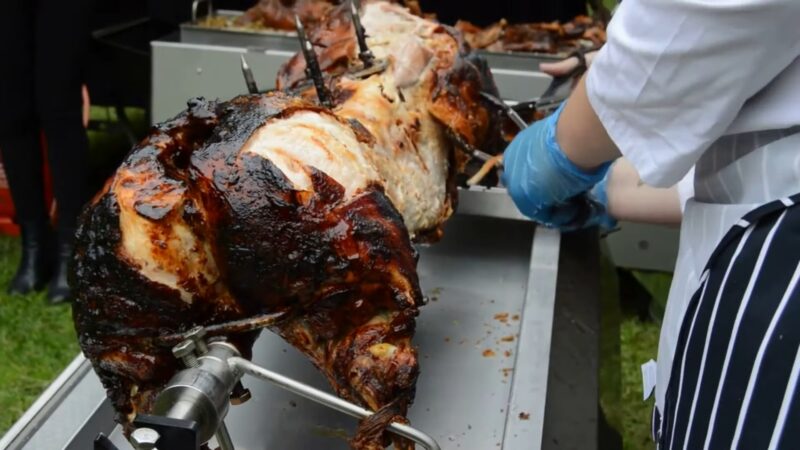
To achieve the perfect pig roast, it’s essential to follow some expert tips and tricks that will help you navigate the cooking process with confidence. Roasting a whole pig is a labor of love, and attention to detail will ensure a mouthwatering result that will impress your guests.
First, remember that the key to a successful pig roast is maintaining a consistent temperature throughout the cooking process. This can be achieved by arranging the coals evenly beneath the pig, using a long set of tongs to adjust as needed. The goal is to create a slow, even heat that will cook the pig to tender perfection.
Another important tip is to keep a close eye on the skin of the pig. As the roast progresses, the skin will begin to crisp up and develop a beautiful golden color. To ensure a crispy, crackling finish, it’s essential to increase the heat during the final half hour of cooking. This will give the pig a deliciously crunchy exterior that will have your guests coming back for seconds.
Expert Quote:
“Maintaining a constant temperature and achieving a crispy skin are the two keys to a perfect pig roast.” – Chef John Smith
Lastly, don’t forget to let the pig rest before carving and serving. This allows the juices to redistribute and ensures a moist and flavorful meat. Cover the pig loosely with foil and let it rest for at least 30 minutes before carving.
| Expert Tip | Details |
|---|---|
| Use a Chimney Starter | A chimney starter is a great tool for lighting the coals quickly and efficiently. It eliminates the need for lighter fluid, which can leave a chemical taste on the meat. |
| Invest in a Quality Meat Thermometer | To ensure the pig is cooked to the correct internal temperature, invest in a quality meat thermometer. This will help you avoid undercooking or overcooking the meat. |
| Consider Hiring a Spitmaster | If you’re new to pig roasting or simply want to enjoy the event without worrying about the cooking process, consider hiring a spitmaster. They will handle all aspects of the roasting, allowing you to relax and enjoy the festivities. |
Cleaning up and Serving
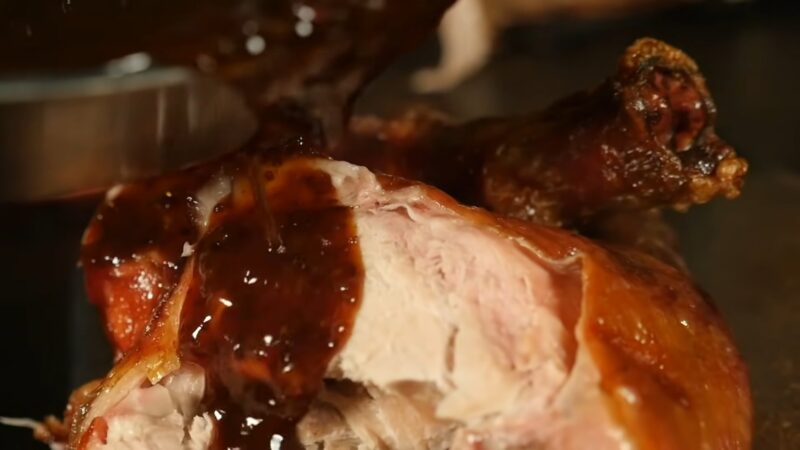
Once the pig roast is complete and the pig has reached its mouthwatering state of perfection, it’s time to clean up and serve the star attraction to your eager guests. Cleaning up after a pig roast may seem daunting, but with a well-organized plan, it can be a smooth and efficient process.
First, ensure that the fire has been completely extinguished. Make sure to pour water or sand over the coals and embers to extinguish any remaining heat. Once the fire is safely put out, remove any leftover ashes from the fire pan or pit, and dispose of them properly. This will help prevent any accidental fires or injuries.
Next, gather your serving utensils and carving equipment. A sharp carving knife, cutting board, and tongs will be essential in serving the succulent roasted pig. Carefully remove the pig from the rotisserie spit, making sure to steady it with sturdy kitchen gloves to avoid any accidents. Place the pig on the cutting board and let it rest for a few minutes before carving.
While the pig is resting, finalize your serving area and set up the necessary condiments and side dishes. Arrange the pig on a large platter or cutting board, garnishing it with fresh herbs and fruits for an added visual appeal. Provide serving plates, utensils, and napkins to make it easier for your guests to enjoy the delicious feast. Ensure that the side dishes, such as cole slaw and potatoes, are also readily available to complete the meal.
Table 1: Essential Cleaning and Serving Supplies
| Supplies | Quantity |
|---|---|
| Fire extinguisher | 1 |
| Water or sand | Enough to fully extinguish the fire |
| Disposable gloves | 1 pair per person |
| Sharp carving knife | 1 |
| Cutting board | 1 |
| Tongs | 1 pair |
| Large platter or cutting board | 1 |
| Fresh herbs and fruits for garnishing | As desired |
| Serving plates, utensils, and napkins | As needed |
With the clean-up complete and the pig expertly carved, it’s time to savor the fruits of your labor. Invite your guests to indulge in the delectable flavors, and revel in the joy and satisfaction that comes from successfully executing a rotisserie pig roast. Remember to savor the experience, as it’s not just about the food but also about the memories created with friends and family.
Conclusion
In conclusion, a rotisserie pig roast is an exhilarating experience that brings people together and leaves a lasting impression with its delicious flavors and festive ambiance. Roasting a whole pig on a rotisserie spit is not only a culinary adventure but also a celebration of community and tradition.
When hosting a pig roast, it is essential to plan and prepare meticulously. Sending out invitations to guests and decorating the area with pig-themed decorations sets the mood for a fun-filled event. The spit itself can be easily constructed using a simple steel pipe, supported by sturdy cinder blocks or other structures. Ensuring that the pig is securely attached to the spit is crucial for an even rotation and a successful roast. Bailing wire or steel prongs can be used for this purpose.
Creating a fire pan or pit is necessary to protect the ground and catch drippings, while splitting wood provides a good bed of coals for cooking. As the fire crackles and the pig gently rotates, it’s the perfect time to prepare delicious side dishes that complement the star of the show. Classic favorites like cole slaw and potatoes can be prepared to delight guests’ taste buds.
Purchasing the pig from a reputable source is important, ensuring that each guest will have approximately one pound of succulent roasted pig to enjoy. Seasoning the pig with salt enhances its natural flavors and adds an irresistible taste. The cooking process involves maintaining a slow, even heat for several hours, allowing the pig to cook through evenly. In the final half hour, the heat can be increased to crisp up the skin, creating a mouthwatering golden-brown exterior.
To bring it all together, lighting the coals with a chimney starter and using long tongs to arrange them underneath the pig during cooking helps ensure a consistent and flavorful result. It’s worth noting that keeping the guest list limited and under control is crucial to avoid overcrowding and create a comfortable atmosphere for everyone to enjoy.
Ultimately, a rotisserie pig roast is not just about the delicious food; it’s about the memories created and the bonds formed with friends and family. Whether it’s a backyard gathering or a larger event, a pig roast provides an unforgettable experience that embodies the spirit of togetherness and culinary delight. So, gather your loved ones, fire up the rotisserie, and get ready for an extraordinary gastronomic adventure!
FAQ
How do I secure the pig to the spit?
The pig can be secured to the spit using baling wire or steel prongs. It is important to ensure that the pig is securely attached to the spit to prevent it from falling off during cooking.
How do I prepare the fire pit?
To prepare the fire pit, you will need to create a fire pan or pit to protect the ground and catch any drippings. It is also important to split a sufficient amount of wood to create a good bed of coals for cooking.
How should I season the pig?
Seasoning the pig with salt is a simple yet effective way to enhance its natural flavors. Sprinkle salt all over the pig, ensuring that it is evenly coated.
What is the cooking process for a pig roast?
The cooking process involves maintaining a slow and even heat for several hours, followed by increasing the heat in the last half hour to crisp up the skin. This results in a tender and flavorful roasted pig.
What side dishes should I prepare for a pig roast?
Some popular side dishes to accompany a pig roast include cole slaw, potatoes, and other grilled vegetables. These dishes complement the flavors of the roasted pig and provide a well-rounded meal for your guests.
How do I manage the guest list for a pig roast?
It is important to keep the guest list limited and under control to avoid overcrowding. This ensures that everyone can comfortably enjoy the pig roast and have an enjoyable experience.
What are some tips for a perfect pig roast?
Some tips for a perfect pig roast include using a chimney starter to light the coals, arranging the coals underneath the pig during cooking using long tongs, and monitoring the temperature to ensure even cooking.
How do I clean up and serve the pig after it is cooked?
After the pig is cooked, you will need to clean up the area by disposing of any waste properly. Then, carve the pig and serve the delicious roasted meat to your guests.
Final Words
In conclusion, a rotisserie pig roast is an exhilarating experience that brings people together and leaves a lasting impression with its delicious flavors and festive ambiance. Roasting a whole pig on a rotisserie spit is not only a culinary adventure but also a celebration of community and tradition.
Ultimately, a rotisserie pig roast is not just about the delicious food; it’s about the memories created and the bonds formed with friends and family. Whether it’s a backyard gathering or a larger event, a pig roast provides an unforgettable experience that embodies the spirit of togetherness and culinary delight.

